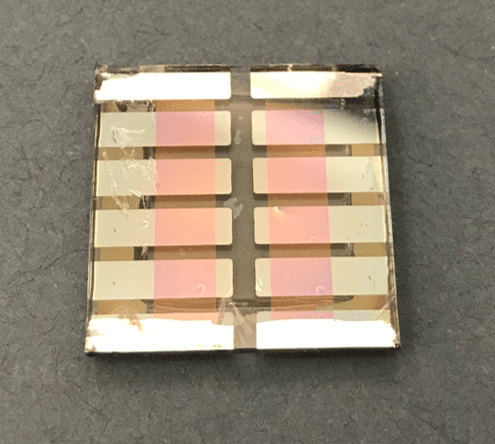Scientists at the University of Strathclyde in the United Kingdom have fabricated an organic solar (OPV) device for applications in high-speed optical wireless communication (OWC) which is claimed to operate as an energy-harvesting device and, simultaneously, as a high-speed data detector.
The academics stated that organic PV technology is particularly suitable for this kind of application due to its low cost and flexibility, which enables its integration into internet-connected devices. “Powering a large portion of connected mobile Internet-of-Thing (IoT) devices using flexible OPVs is an attractive solution to overcome the burden of having to charge devices regularly,” they also explained.
The PV device was built with an inverted architecture based on metal oxide-based charge-selective transport layers and metal electrodes made of gold and silver, which the British group said improves the device's performance stability. It consists of a 4×2.5mm photoactive layer fabricated with a bulk heterojunction of a polymer donor and fullerene and non-fullerene acceptors.
“Under 1 Sun intensity (100 mW/cm2), these solar cells demonstrate a power conversion efficiency (PCE) of 8.8%, and under artificial indoor low-light-intensity illumination (0.3–6 mW/cm2), the PCE is 14%,” the researchers specified.
Four cells of this kind were assembled with a laser-based point-to-point OWC system to build a multiple-input multiple-output (MIMO) system consisting of four laser diodes. The PV devices have separate contacts and the output current from each of them is individually accessible, which means the cells can be used as separate receivers or their signals be combined so that the whole system acts as one receiver.
“The transmitted power of each laser is 56.2 mW,” they further explained. “A data rate of 147.5 Mb/s is achieved with a single-input single-output (SISO) OPV-based system, which is the highest reported data rate with OPVs to the best of the authors’ knowledge. […] These values are further increased to 221 Mb/s or 363 Mb/s and 6.8 mW or 10.9 mW of harvested energy by implementing a 2-by-2 or 4-by-4 OPV-based MIMO system, respectively, for the first time.”
The proposed system configuration, the scientists stated, is designed for a system with four light transmitters and four OPV cells integrated into a single panel, The methodology they applied, however, is claimed to be generally applicable. “As a result, by using the proposed method, it is possible to trade the physical size of the system for both harvested energy and data rate,” they added.
The system is presented in the paper Organic photovoltaics for simultaneous energy harvesting and high-speed MIMO optical wireless communications, published in Light | Science & Applications.
This content is protected by copyright and may not be reused. If you want to cooperate with us and would like to reuse some of our content, please contact: editors@pv-magazine.com.




By submitting this form you agree to pv magazine using your data for the purposes of publishing your comment.
Your personal data will only be disclosed or otherwise transmitted to third parties for the purposes of spam filtering or if this is necessary for technical maintenance of the website. Any other transfer to third parties will not take place unless this is justified on the basis of applicable data protection regulations or if pv magazine is legally obliged to do so.
You may revoke this consent at any time with effect for the future, in which case your personal data will be deleted immediately. Otherwise, your data will be deleted if pv magazine has processed your request or the purpose of data storage is fulfilled.
Further information on data privacy can be found in our Data Protection Policy.